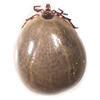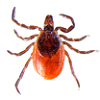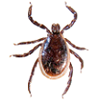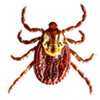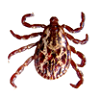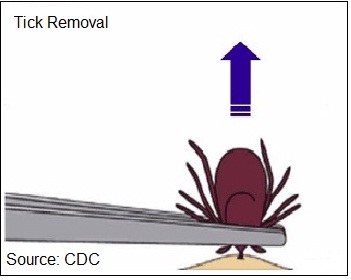Blacklegged ticks in Hamilton
Ticks live in wooded areas or dense bushy areas with leaf litter or tall grasses. Blacklegged ticks prefers wooded or dense bushy areas and are not typically found in lawns, landscaped areas, sport fields or paved areas.
Blacklegged and other types of ticks are spread into new areas by travelling on birds, deer and other animals, attaching to feed and falling off when done. Blacklegged tick populations have been found in Hamilton. The overall risk of Lyme disease infection in Hamilton is considered low. Blacklegged tick populations can occur sporadically over a wide geographic range in Canada due to larvae and nymphs readily attaching themselves to migratory birds. Although the risk is low, there is a chance of encountering an infective tick in a location outside the estimated risk areas.
Blacklegged ticks are the only known ticks that can transmit Lyme disease in Ontario. (Photo credit: URI Tick Encounter Resource Centre)
American dog ticks (seen below) are the most common tick found in our area, they cannot transmit Lyme disease. (Photo credit: URI Tick Encounter Resource Centre)
Hamilton is considered a risk area for Lyme disease.
This risk area covers a 20 kilometre radius that includes all parts of the city except eastern parts of Stoney Creek and Glanbrook. While Hamilton is now identified as a risk area, the overall risk of human infection from Lyme disease in Hamilton remains low. There is a higher estimated risk of encountering a blacklegged tick within a risk area.
Public Health Ontario’s Lyme disease estimated risk areas map, 2024 shows areas in Ontario where there is a greater chance of encountering blacklegged ticks. Refer to PHO website for further details.
The suitable tick habitat is predicted to expand in Canada based on several factors, such as climate change, specifically the increase to the temperatures, land use changes(i.e., farmland to forest; encroaching human populations; forest fragmentation, and the expansion of the territory of the hosts to the blacklegged ticks. Information from the Public Health Ontario websites states “All tick surveillance indicators suggest that the current geographic range of blacklegged tick populations is expanding in southern Ontario and will likely continue to do so, as available habitat permits.”
Submit a tick for identification
The tick identification that Public Health Services provides is for surveillance purposes only and is not intended for specific diagnosis or treatment decisions for any patient. If exposed to a black legged tick, please contact your physician for treatment advice.
Tick testing sample kits can be picked up year round at:
To submit the tick to Public Health Services for identification:
- Save the tick in a clear jar, screw-top bottle or zip-lock bag. If possible, keep the tick alive.
- The tick must be loose in the jar, bottle or bag.
- Do not put the tick in any liquid or attach it to paper or tape.
- Fill out information on the tick label included in the testing sample kit
- Or email a clear photo of the tick to [email protected] and provide location where tick was obtained.
Important information for tick testing
- Take note of the following information before you bring a tick in for identification:
- We no longer test blacklegged ticks for Lyme disease if they were found on a person. Persons exposed to blacklegged ticks should consult with health care provider for possible treatment.
- We will not test ticks found on dogs or animals for Lyme disease.
- Public Health staff will look at and identify all ticks submitted.
- Public Health staff will call you within two to five business days to let you know the identification of the tick.


